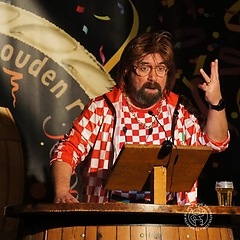In many places in the Netherlands carillon music is heard at certain hours. Such bell music concerts are produced by carillonneurs. A carillon consists of a series of chromatically tuned (going up by semitones only) bells and is played with a so-called baton keyboard, consisting of a manual and a pedal. The manual is played with the fists, therefore the keys are further apart than with a piano. The keys, (of both manual and pedal) hinge in the back of the keyboard. Every key is connected by a cable with the clapper of the respective bell. The bells themselves do not move. The clapper hangs on the inside of the bell and is pulled against the bottom inside of the bell by striking a key. The most common are carillons with a reach of four octaves (between 47 and 49 bells). The bells are cast in bronze. The diameter and the profile of the bell determine the pitch and the sound. Many carillons can be played by means of an automated mechanism or a drum. In this case often a short melody is played every quarter of an hour and a longer version at the whole or half hour. The carillonneur takes care of programming the machine. He must then re-pin the drum. There are also modern, computerised systems.



